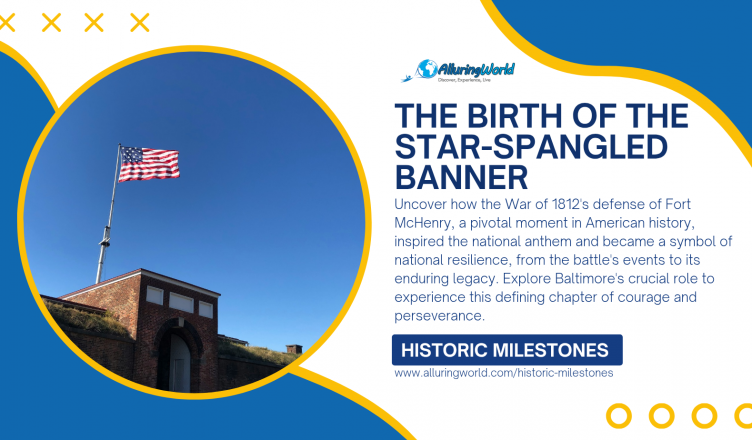Read time ca. 4 minutes
Throughout American history, there have been moments that defined the country’s character and shaped its identity. The defense of Fort McHenry during the War of 1812 is one such event. Located at the mouth of Baltimore Harbor, the fort became the stage for a dramatic confrontation that would inspire an enduring national anthem and symbolize the perseverance of a young nation. To fully appreciate this milestone, it is essential to explore the circumstances leading up to the battle, the people involved, and its far-reaching legacy.
The War of 1812 and the Road to Baltimore
The War of 1812 erupted from disputes over trade restrictions, British impressment of American sailors, and tensions surrounding territorial expansion. For the United States, still a young republic, the conflict was as much about asserting independence as it was about defending borders. By the summer of 1814, British forces had burned Washington, D.C., demonstrating their strength and leaving Americans shaken. Baltimore, a thriving port city with shipbuilders known for fast privateers, was the next target.
British commanders believed that taking Baltimore would strike a decisive blow. Yet Baltimoreans were prepared. Local militia, supported by citizens, reinforced defenses across the city. Trenches were dug, artillery was positioned, and supplies were stockpiled. Fort McHenry, a star-shaped fortress guarding the harbor, stood as the cornerstone of these preparations. If the fort fell, Baltimore would likely fall with it.
The Siege of Fort McHenry
On September 13, 1814, the British fleet began its assault. Over 25 intense hours, more than a thousand shells and rockets rained down upon the fort. The sky was lit by explosions, and the thunder of cannons echoed across the harbor. Inside, approximately 1,000 soldiers under Major George Armistead endured the relentless attack. They repaired damage during brief lulls, kept their artillery firing, and refused to surrender.
Despite brutal conditions, morale at Fort McHenry remained high. A damaged flag was replaced with a larger one, visible from British ships. At dawn on September 14, the massive flag still waved, signaling British withdrawal. Baltimore was saved, turning the war’s tide.
Francis Scott Key and His Inspiration
Among those witnessing the attack was Francis Scott Key, a lawyer negotiating the release of an American prisoner aboard a British vessel. Held on the ship during the bombardment, he anxiously observed the fort through the night. At dawn, seeing the American flag still waving, he was filled with pride. This moment inspired him to write The Defence of Fort M’Henry, a poem set to music that spread across the country as The Star-Spangled Banner. Over time, it became a unifying song and in 1931 was adopted as the national anthem.
The flag that Key described grew into a lasting emblem of resilience. Today it is preserved at the Smithsonian Institution, where visitors reflect on its significance. Fort McHenry, now a National Monument and Historic Shrine, shares this story through reenactments, exhibits, and tours, teaching new generations about the courage that shaped American history.
Baltimore’s Role in American History
Baltimore’s contribution during the War of 1812 extended far beyond the fort. Local shipbuilders created vessels that challenged British naval supremacy. Citizens fortified defenses and supplied troops, demonstrating unity in a time of crisis. The successful defense not only secured the city but also boosted national morale, helping pave the way toward eventual peace negotiations.
Baltimore preserves the memory of the battle through monuments, commemorations, and historical societies, embracing its role as a resilient city celebrating the courage of those who stood their ground.
Visiting Fort McHenry Today
Modern visitors to Baltimore can explore Fort McHenry and experience the echoes of history firsthand. Walking through the ramparts, exploring reconstructed barracks, and attending daily flag-raising ceremonies bring the story to life. Interactive exhibits detail the battle’s events, while guided tours explain its broader significance. Beyond the fort, other neighborhoods and museums in Baltimore provide context for the city’s 19th-century history. For those planning to visit several sites, arranging a Baltimore car service can help with logistics while visitors immerse themselves in the historical experience.
A Legacy That Endures
The defense of Fort McHenry remains one of the defining episodes in American history. It preserved a city, inspired a national anthem, and strengthened the country’s resolve. More than two centuries later, its legacy continues to resonate with those who walk the grounds or sing the anthem. The story serves as a reminder that courage in the face of overwhelming odds can create symbols that last for generations.
Standing at the fort today, with the flag waving high, visitors can still feel the spirit of those who endured that long night. Their resilience shaped a nation’s identity, leaving a legacy that continues to inspire.

